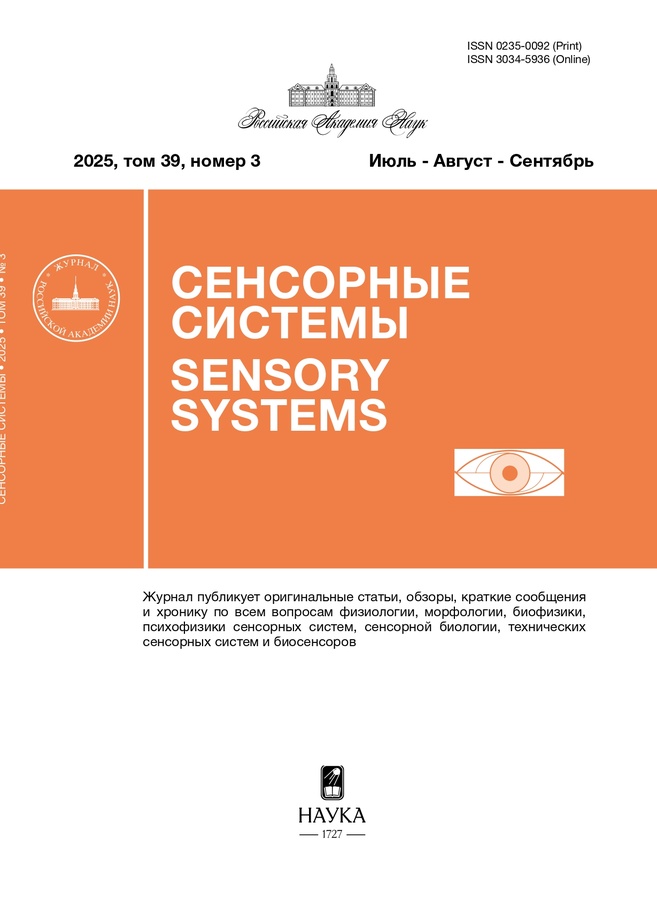Зрительные электронные протезы
- Авторы: Фирсов М.Л.1
-
Учреждения:
- Институт эволюционной физиологии и биохимии им. И.М. Сеченова РАН
- Выпуск: Том 37, № 3 (2023)
- Страницы: 205-217
- Раздел: ОБЗОРЫ
- URL: https://journals.rcsi.science/0235-0092/article/view/138230
- DOI: https://doi.org/10.31857/S0235009223030046
- EDN: https://elibrary.ru/ZWRQFK
- ID: 138230
Цитировать
Полный текст
Аннотация
Электронные импланты в сетчатке представляют собой многообещающую технологию для частичного восстановления зрения при тяжелых нейродегенеративных заболеваниях. Их основная идея заключается в том, что они заменяют поврежденные фоторецепторы электронными устройствами, которые преобразовывают световые сигналы в электрические импульсы, стимулирующие биполярные или ганглиозные клетки сетчатки. В настоящем обзоре рассмотрены история создания этой технологии и современное состояние дел в этой области, а также различные варианты конструкций и принципы работы ретинальных имплантов.
Ключевые слова
Об авторах
М. Л. Фирсов
Институт эволюционной физиологии и биохимии им. И.М. Сеченова РАН
Автор, ответственный за переписку.
Email: Michael.Firsov@gmail.com
Россия,
194223, Санкт-Петербург, пр. Тореза 44
Список литературы
- Островский М.А., Кирпичников М.П. Перспективы оптогенетического протезирования дегенеративной сетчатки глаза. Биохимия. 2019. V. 84 (5). P. 634–647.
- Фирсов М.Л. Перспективы оптогенетического протезирования сетчатки. Журнал высшей нервной деятельности им ИП Павлова. 2017. V. 67 (5). P. 53–62.
- Arens-Arad T., Farah N., Lender R., Moshkovitz A., Flores T., Palanker D. Cortical Interactions between Prosthetic and Natural Vision. Current biology: CB. 2020. V. 30 (1). P. 176–182 e172. https://doi.org/10.1016/j.cub.2019.11.028
- Asghar S.A., Pal P., Nazeer K., Mahadevappa M. A Computational Study of Graphene as a Prospective Material for Microelectrodes in Retinal Prosthesis and Electric Crosstalk Analysis. Annual International Conference of the IEEE Engineering in Medicine and Biology Society IEEE Engineering in Medicine and Biology Society Annual International Conference. 2020. V. 2020. P. 2291–2294. https://doi.org/10.1109/EMBC44109.2020.9176388
- Caspi A., Barry M.P., Patel U.K., Salas M.A., Dorn J.D., Roy A. Eye movements and the perceived location of phosphenes generated by intracranial primary visual cortex stimulation in the blind. Brain stimulation. 2021. V. 14 (4). P. 851–860. https://doi.org/10.1016/j.brs.2021.04.019
- Caspi A., Dorn J.D., McClure K.H., Humayun M.S., Greenberg R.J., McMahon M.J. Feasibility study of a retinal prosthesis: spatial vision with a 16-electrode implant. Archives of ophthalmology. 2009. V. 127 (4). P. 398-401. https://doi.org/10.1001/archophthalmol.2009.20
- Choi C., Choi M.K., Liu S., Kim M.S., Park O.K., Im C. Human eye-inspired soft optoelectronic device using high-density MoS(2)-graphene curved image sensor array. Nature communications. 2017. V. 8 (1). P. 1664. https://doi.org/10.1038/s41467-017-01824-6
- Chow A.Y., Chow V.Y., Packo K.H., Pollack J.S., Peyman G.A., Schuchard R. The artificial silicon retina microchip for the treatment of visionloss from retinitis pigmentosa. Archives of ophthalmology. 2004. V. 122 (4). P. 460–469. https://doi.org/10.1001/archopht.122.4.460
- da Cruz L., Dorn J.D., Humayun M.S., Dagnelie G., Handa J., Barale P.O. Five-Year Safety and Performance Results from the Argus II Retinal Prosthesis System Clinical Trial. Ophthalmology. 2016. V. 123 (10). P. 2248–2254. https://doi.org/10.1016/j.ophtha.2016.06.049
- Daschner R., Greppmaier U., Kokelmann M., Rudorf S., Rudorf R., Schleehauf S. Laboratory and clinical reliability of conformally coated subretinal implants. Biomedical microdevices. 2017. V. 19 (1). P. 7. https://doi.org/10.1007/s10544-017-0147-6
- Daschner R., Rothermel A., Rudorf R., Rudorf S., Stett A. Functionality and Performance of the Subretinal Implant Chip Alpha AMS. Sensors and Materials. 2018. V. 30 (2, SI). P. 179–192. https://doi.org/10.18494/SAM.2018.1726
- De Silva S.R., Moore A.T. Optogenetic approaches to therapy for inherited retinal degenerations. J Physiol. 2022. V. 600 (21). P. 4623–4632. https://doi.org/10.1113/JP282076
- Demchinsky A.M., Shaimov T.B., Goranskaya D.N., Moiseeva I.V., Kuznetsov D.I., Kuleshov D.S. The first deaf-blind patient in Russia with Argus II retinal prosthesis system: what he sees and why. Journal of neural engineering. 2019. V. 16 (2). P. 025002. https://doi.org/10.1088/1741-2552/aafc76
- Edwards T.L., Cottriall C.L., Xue K., Simunovic M.P., Ramsden J.D., Zrenner E. Assessment of the Electronic Retinal Implant Alpha AMS in Restoring Vision to Blind Patients with End-Stage Retinitis Pigmentosa. Ophthalmology. 2018. V. 125 (3). P. 432–443. https://doi.org/10.1016/j.ophtha.2017.09.019
- Eickenscheidt M., Herrmann T., Weisshap M., Mittnacht A., Rudmann L., Zeck G. An optoelectronic neural interface approach for precise superposition of optical and electrical stimulation in flexible array structures. Biosensors & bioelectronics. 2022. V. 205. P. 114090. https://doi.org/10.1016/j.bios.2022.114090
- Feldman T., Dontsov A., Yakovleva M., Ostrovsky M.A. Photobiology of lipofuscin granules in the retinal pigment epithelium cells of the eye: norm, pathology, age. Biophysical Reviews. 2022. V. 14 (4). P. 1051–1065. https://doi.org/10.1007/s12551-022-00989-9
- Ghani N., Bansal J., Naidu A., Chaudhary K.M. Long term positional stability of the Argus II retinal prosthesis epiretinal implant. BMC ophthalmology. 2023. V. 23 (1). P. 70. https://doi.org/10.1186/s12886-022-02736-w
- Goetz G.A., Palanker D.V. Electronic approaches to restoration of sight. Reports on progress in physics Physical Society. 2016. V. 79 (9). P. 096701. https://doi.org/10.1088/0034-4885/79/9/096701
- Hornig R., Zehnder T., Velikay-Parel M., Laube T., Feucht M., Richard G. The IMI retinal implant system. Artificial Sight: Basic Research, Biomedical Engineering, and Clinical Advances. 2007. V. P. 111–128. https://doi.org/10.1007/978-0-387-49331-2_6
- Humayun M.S., de Juan E., Jr., Weiland J.D., Dagnelie G., Katona S., Greenberg R. Pattern electrical stimulation of the human retina. Vision research. 1999. V. 39 (15). P. 2569–2576. https://doi.org/10.1016/s0042-6989(99)00052-8
- Humayun M.S., Weiland J.D., Fujii G.Y., Greenberg R., Williamson R., Little J. Visual perception in a blind subject with a chronic microelectronic retinal prosthesis. Vision research. 2003. V. 43 (24). P. 2573–2581. https://doi.org/10.1016/s0042-6989(03)00457-7
- Jiang L, Lu G., Zeng Y., Sun Y., Kang H., Burford J. Flexible ultrasound-induced retinal stimulating piezo-arrays for biomimetic visual prostheses. Nature communications. 2022. V. 13 (1). P. 3853. https://doi.org/10.1038/s41467-022-31599-4
- Jones B.W., Kondo M., Terasaki H., Lin Y., McCall M., Marc R.E. Retinal remodeling. Jpn J Ophthalmol. 2012. V. 56 (4). P. 289–306. https://doi.org/10.1007/s10384-012-0147-2
- Kleinlogel S., Vogl C., Jeschke M., Neef J., Moser T. Emerging Approaches for Restoration of Hearing and Vision. Physiol Rev. 2020. V. 100 (4). P. 1467–1525. https://doi.org/10.1152/physrev.00035.2019
- Lorach H., Palanker D. High resolution photovoltaic subretinal prosthesis for restoration of sight. Artificial Vision: A Clinical Guide. 2017. V. P. 115–124. https://doi.org/10.1007/978-3-319-41876-6_9
- Luo Y.H., da Cruz L. The Argus((R)) II Retinal Prosthesis System. Progress in retinal and eye research. 2016. V. 50. P. 89–107. https://doi.org/10.1016/j.preteyeres.2015.09.003
- Luo Y.H., Fukushige E., Da Cruz L. The potential of the second sight system bionic eye implant for partial sight restoration. Expert review of medical devices. 2016. V. 13 (7). P. 673–681. https://doi.org/10.1080/17434440.2016.1195257
- Martinez-Fernandez de la Camara C., Cehajic-Kapetanovic J., MacLaren R.E. Emerging gene therapy products for RPGR-associated X-linked retinitis pigmentosa. Expert Opinion on Emerging Drugs. 2022. V. 27 (4). P. 431–443. https://doi.org/10.1080/14728214.2022.2152003
- Montezuma S.R., Sun S.Y., Roy A., Caspi A., Dorn J.D., He Y. Improved localisation and discrimination of heat emitting household objects with the artificial vision therapy system by integration with thermal sensor. The British journal of ophthalmology. 2020. V. 104 (12). P. 1730–1734. https://doi.org/10.1136/bjophthalmol-2019-315513
- Muqit M.K., Velikay-Parel M., Weber M., Dupeyron G., Audemard D., Corcostegui B. Six-Month Safety and Efficacy of the Intelligent Retinal Implant System II Device in Retinitis Pigmentosa. Ophthalmology. 2019. V. 126 (4). P. 637–639. https://doi.org/10.1016/j.ophtha.2018.11.010
- Newton F., Megaw R. Mechanisms of Photoreceptor Death in Retinitis Pigmentosa. Genes (Basel). 2020. V. 11 (10). P. 1120. https://doi.org/10.3390/genes11101120
- Palanker D., Le Mer Y., Mohand-Said S., Muqit M., Sahel J.A. Photovoltaic Restoration of Central Vision in Atrophic Age-Related Macular Degeneration. Ophthalmology. 2020. V. 127 (8). P. 1097–1104. https://doi.org/10.1016/j.ophtha.2020.02.024
- Palanker D., Le Mer Y., Mohand-Said S., Sahel J.A. Simultaneous perception of prosthetic and natural vision in AMD patients. Nature communications. 2022. V. 13 (1). P. 513. https://doi.org/10.1038/s41467-022-28125-x
- Peterman M.C., Mehenti N.Z., Bilbao K.V., Lee C.J., Leng T., Noolandi J. The Artificial Synapse Chip: a flexible retinal interface based on directed retinal cell growth and neurotransmitter stimulation. Artificial organs. 2003. V. 27 (11). P. 975–985. https://doi.org/10.1046/j.1525-1594.2003.07307.x
- Pfeiffer R.L., Marc R.E., Jones B.W. Persistent remodeling and neurodegeneration in late-stage retinal degeneration. Progress in retinal and eye research. 2020. V. 74. P. 100771. https://doi.org/10.1016/j.preteyeres.2019.07.004
- Piri N., Grodsky J.D., Kaplan H.J. Gene therapy for retinitis pigmentosa. Taiwan J Ophthalmol. 2021. V. 11 (4). P. 348–351. https://doi.org/10.4103/tjo.tjo_47_21
- Rachitskaya A.V., DeBenedictis M., Yuan A. What Happened to Retinal Prostheses?: LWW; 2020. P. 803–804.
- Schaffrath K., Lohmann T., Seifert J., Ingensiep C., Raffelberg P., Waschkowski F. New epiretinal implant with integrated sensor chips for optical capturing shows a good biocompatibility profile in vitro and in vivo. Biomedical engineering online. 2021. V. 20 (1). P. 102. https://doi.org/10.1186/s12938-021-00938-9
- Shire D.B., Gingerich M.D., Wong P.I., Skvarla M., Cogan S.F., Chen J. Micro-Fabrication of Components for a High-Density Sub-Retinal Visual Prosthesis. Micromachines. 2020. V. 11 (10). P. https://doi.org/10.3390/mi11100944
- Song D.J., Bao X.L., Fan B., Li G.Y. Mechanism of Cone Degeneration in Retinitis Pigmentosa. Cell Mol Neurobiol. 2023. V. 43 (3). P. 1037–1048. https://doi.org/10.1007/s10571-022-01243-2
- Stanga P.E., Tsamis E., Siso-Fuertes I, Dorn J.D., Merlini F., Fisher A. Electronic retinal prosthesis for severe loss of vision in geographic atrophy in age-related macular degeneration: First-in-human use. European journal of ophthalmology. 2021. V. 31 (3). P. 920–931. https://doi.org/10.1177/11206721211000680
- Stiles N.B., Patel V.R., Weiland J.D. Multisensory perception in Argus II retinal prosthesis patients: Leveraging auditory-visual mappings to enhance prosthesis outcomes. Vision research. 2021. V. 182. P. 58–68. https://doi.org/10.1016/j.visres.2021.01.008
- Stingl K., Bartz-Schmidt K.U., Besch D., Braun A., Bruckmann A., Gekeler F. Artificial vision with wirelessly powered subretinal electronic implant alpha-IMS. Proceedings Biological sciences. 2013. V. 280 (1757). P. 20130077. https://doi.org/10.1098/rspb.2013.0077
- Stingl K., Bartz-Schmidt K.U., Besch D., Chee C.K., Cottriall C.L., Gekeler F. Subretinal Visual Implant Alpha IMS–Clinical trial interim report. Vision research. 2015. V. 111 (Pt B). P. 149–160. https://doi.org/10.1016/j.visres.2015.03.001
- Thomas C.J., Mirza R.G., Gill M.K. Age-related macular degeneration. Medical Clinics. 2021. V. 105 (3). P. 473–491. https://doi.org/10.1016/j.mcna.2021.01.003
- Wang B.Y., Chen Z.C., Bhuckory M., Huang T., Shin A., Zuckerman V. Electronic photoreceptors enable prosthetic visual acuity matching the natural resolution in rats. Nature communications. 2022. V. 13 (1). P. 6627. https://doi.org/10.1038/s41467-022-34353-y
- Werginz P., Wang B.Y., Chen Z.C., Palanker D. On optimal coupling of the 'electronic photoreceptors' into the degenerate retina. Journal of neural engineering. 2020. V. 17 (4). P. 045008. https://doi.org/10.1088/1741-2552/aba0d2
- Wu K.Y., Kulbay M., Toameh D., Xu A.Q., Kalevar A., Tran S.D. Retinitis Pigmentosa: Novel Therapeutic Targets and Drug Development. Pharmaceutics. 2023. V. 15 (2). P. 685. https://doi.org/;10.3390/pharmaceutics15020685
- Yu Z.H., Chen W.J., Liu X., Xia Q.Y., Yang Y.N., Dong M. Folate-Modified Photoelectric Responsive Polymer Microarray as Bionic Artificial Retina to Restore Visual Function. ACS applied materials & interfaces. 2020. V. 12 (25). P. 28759–28767. https://doi.org/10.1021/acsami.0c04058
- Yue L., Castillo J., Gonzalez A.C., Neitz J., Humayun M.S. Restoring Color Perception to the Blind: An Electrical Stimulation Strategy of Retina in Patients with End-stage Retinitis Pigmentosa. Ophthalmology. 2021. V. 128 (3). P. 453–462. https://doi.org/10.1016/j.ophtha.2020.08.019
- Zhou D.D., Dorn J.D., Greenberg R.J. The Argus® II retinal prosthesis system: An overview. 2013 IEEE international conference on multimedia and expo workshops (ICMEW); 2013. P. 1–6. https://doi.org/10.1109/ICMEW.2013.6618428
- Zrenner E., Bartz-Schmidt K.U., Benav H., Besch D., Bruckmann A., Gabel V.P. Subretinal electronic chips allow blind patients to read letters and combine them to words. Proceedings Biological sciences. 2011. V. 278 (1711). P. 1489–1497.
- Zrenner E., Miliczek K.D., Gabel V.P., Graf H.G., Guenther E., Haemmerle H. The development of subretinal microphotodiodes for replacement of degenerated photoreceptors. Ophthalmic research. 1997. V. 29 (5). P. 269–280. https://doi.org/10.1159/000268025
- Zrenner E., Stett A., Weiss S., Aramant R.B., Guenther E., Kohler K. Can subretinal microphotodiodes successfully replace degenerated photoreceptors? Vision research. 1999. V. 39 (15). P. 2555–2567. https://doi.org/10.1016/s0042-6989(98)00312-5
Дополнительные файлы













